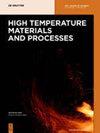Application of laser surface detection technology in blast furnace gas flow control and optimization
IF 1.6
4区 材料科学
Q4 MATERIALS SCIENCE, MULTIDISCIPLINARY
引用次数: 0
Abstract
The gas flow distribution inside a blast furnace affects its smelting. Laser surface detection technology can control the gas flow distribution and promote the stable and smooth running of blast furnace by observing and adjusting the surface condition in the blast furnace in real-time. The laser surface inspection technology in blast furnace gas flow control and optimization was introduced, with Masteel 4,000 m3 blast furnace as an example. The results showed that the 30 W high-power laser had good penetration performance and could obtain clear scanning images of the material surface. In the process of strengthening smelting, the laser detection system determined that the central airflow of blast furnace was insufficient, resulting in a decrease in furnace condition stability, and promptly took measures to adjust the angle of the mineral coke fabric equipment and lifting line. After adjusting the material line, the central airflow was properly suppressed and stabilized, the angle of edge platform increased, the airflow developed properly, and two suitable gas flows were formed, which finally stabilized the furnace condition. Meanwhile, the small duct airflow other than the central airflow was found in time through the laser detection system, which provided conditions for operators to take measures to effectively eliminate the duct airflow, thereby avoiding big impacts on the blast furnace operation and technical and economic indexes. Therefore, the laser surface detection technology could effectively judge the gas flow distribution in the furnace, which contributed to timely adjustment of process parameters and optimization of blast furnace operation.激光表面检测技术在高炉煤气流量控制和优化中的应用
高炉内的煤气流分布影响着高炉的冶炼。激光表面检测技术可通过实时观测和调整高炉内的表面状况,控制煤气流分布,促进高炉稳定平稳运行。以马钢 4000 m3 高炉为例,介绍了激光表面检测技术在高炉煤气流控制与优化中的应用。结果表明,30 W 高功率激光器具有良好的穿透性能,可获得清晰的材料表面扫描图像。在强化冶炼过程中,激光检测系统判定高炉中心风量不足,导致炉况稳定性下降,并及时采取了调整矿焦布料设备和提升线角度的措施。调整料线后,中心气流得到了适当的抑制和稳定,边缘平台角度增大,气流得到了适当的发展,形成了两股合适的煤气流,最终稳定了炉况。同时,通过激光检测系统及时发现了中心气流以外的小风道气流,为操作人员采取措施有效消除风道气流提供了条件,避免了对高炉操作和技术经济指标造成较大影响。因此,激光表面检测技术能有效判断炉内煤气流分布情况,有助于及时调整工艺参数,优化高炉操作。
本文章由计算机程序翻译,如有差异,请以英文原文为准。
求助全文
约1分钟内获得全文
求助全文
来源期刊

High Temperature Materials and Processes
工程技术-材料科学:综合
CiteScore
2.50
自引率
0.00%
发文量
42
审稿时长
3.9 months
期刊介绍:
High Temperature Materials and Processes offers an international publication forum for new ideas, insights and results related to high-temperature materials and processes in science and technology. The journal publishes original research papers and short communications addressing topics at the forefront of high-temperature materials research including processing of various materials at high temperatures. Occasionally, reviews of a specific topic are included. The journal also publishes special issues featuring ongoing research programs as well as symposia of high-temperature materials and processes, and other related research activities.
Emphasis is placed on the multi-disciplinary nature of high-temperature materials and processes for various materials in a variety of states. Such a nature of the journal will help readers who wish to become acquainted with related subjects by obtaining information of various aspects of high-temperature materials research. The increasing spread of information on these subjects will also help to shed light on relevant topics of high-temperature materials and processes outside of readers’ own core specialties.
 求助内容:
求助内容: 应助结果提醒方式:
应助结果提醒方式:


